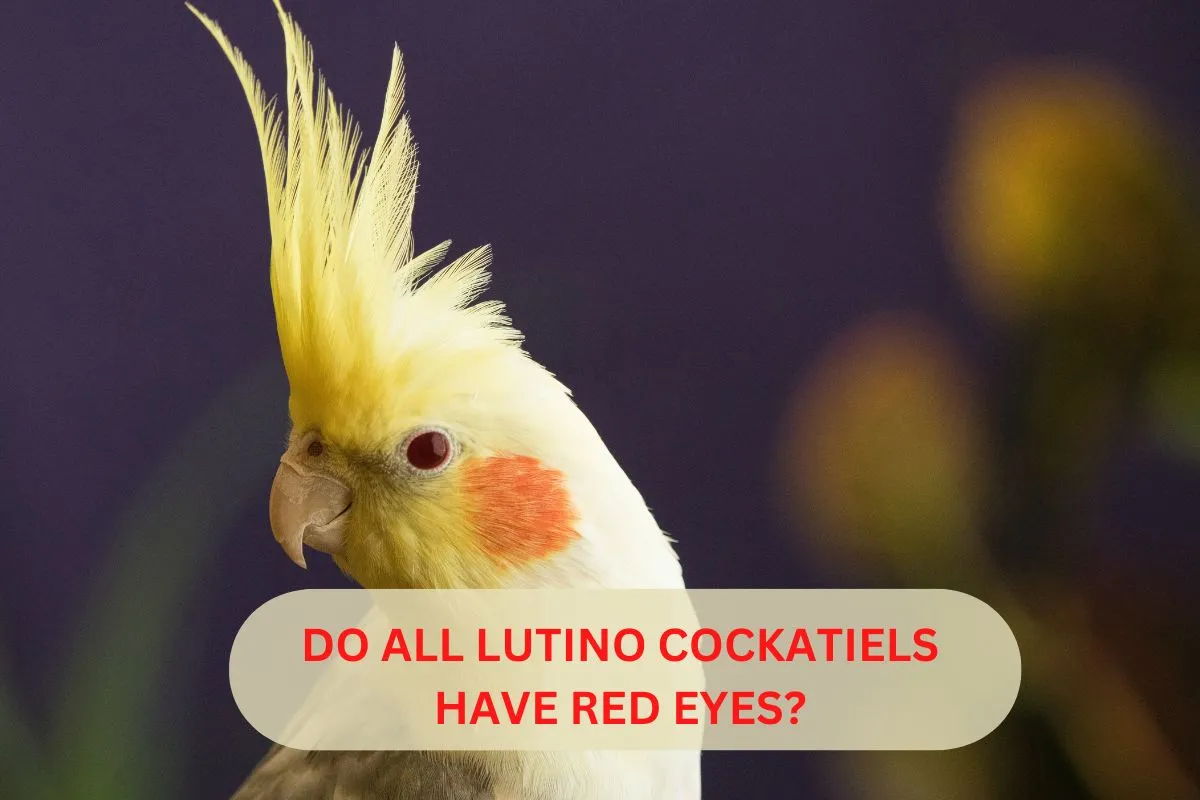One of the distinctive features often associated with lutino cockatiels is their red eyes. While it is true that many lutino cockatiels do have red eyes, it is not a requirement or guarantee for all lutino cockatiels.
Lutino cockatiels are a specific type of bird with a mutation in the genes that determine eye color. It means some lutino cockatiels will have red eyes, while others may have yellow or blue eyes.
The reason for this varies from bird to bird but can be caused by several things. One possible cause is genetics. If a lutino cockatiel’s parents have red eyes, then their offspring may inherit the trait of having red eyes.
Another possible cause is age. Many younger lutino cockatiels may only have blue or yellow eyes, but as they get older and mature, these birds can develop red eyes.
However, if your lutino cockatiel suddenly changes its eye color to red from another color, it can cause an eye infection. I read my recently published articles about eye infection of lutino cockatiel.
Why does my baby cockatiel have red eyes?
One possible cause, baby lutino cockatiels can have red eyes due to a genetic mutation. If the red eyes are because of gene mutation, there is nothing to worry about.
The area around the eye is sensitive and can be discolored or even red when exposed to too much light. In some cases, this may indicate an underlying medical issue such as conjunctivitis.
Suppose you notice that your lutino cockatiel has red eyes that appear suddenly. In that case, it is essential to take them to an avian veterinarian for a checkup and diagnosis as soon as possible.
Factors that can affect eye color in lutino cockatiels
Many factors can affect the eye color of lutino cockatiels. These include genetics, diet, and overall health status.
Genetics plays a significant role in determining the eye color of lutino cockatiels. Some lutino cockatiels may have red eyes due to genetic factors, while others may have black, brown, or yellow eyes.
Diet can also impact eye color in lutino cockatiels. A lack of certain nutrients, such as vitamins A and C, can lead to eye problems, including changes in eye color. Ensuring that lutino cockatiels receive a balanced diet with appropriate levels of these nutrients is vital for maintaining healthy eye color.
Overall health status can also affect eye color in lutino cockatiels. If a lutino cockatiel is experiencing health problems, it may show changes in eye color, such as redness or cloudiness. Ensuring that lutino cockatiels receive proper medical care and attention can help maintain healthy eye color.
Common misconceptions about lutino cockatiels and eye color
There are many misconceptions surrounding the eye color of lutino cockatiels. One common misconception is that all lutino cockatiels have red eyes. However, this is not the case; Lutino cockatiels can have a range of eye colors, including red, black, brown, and yellow.
Another misconception is that lutino cockatiels with red eyes are more valuable or desirable than those with other eye colors. In reality, eye color in lutino cockatiels is not a reliable indicator of the bird’s overall quality or value. What is important is the bird’s health, temperament, and overall conformation.
It is also a misconception that lutino cockatiels with red eyes are more prone to eye problems or health issues. While all cockatiels can be prone to specific eye problems, eye color is not a reliable predictor of a bird’s likelihood of developing these issues.
Providing proper care and nutrition and seeking veterinary treatment when necessary can help maintain the health and well-being of lutino cockatiels, regardless of their eye color.
Red eye lutino cockatiel price
Lutino cockatiels with red eyes typically cost more than those without, as they are considered rarer. This is because the mutation that causes the bright yellow feathers also results in red-eye coloration. Prices for lutino cockatiels can range from $50 to over $200 depending on their age, condition, and where you purchase them from.
Importance of proper breeding practices in lutino cockatiels
Proper breeding practices are important for maintaining the health and well-being of lutino cockatiels. Inbreeding, or the breeding of closely related individuals, can lead to various health problems, including eye problems.
It is important to ensure that lutino cockatiels are bred from unrelated individuals to reduce the risk of health problems and produce healthy offspring.
In addition to avoiding inbreeding, it is important to ensure that lutino cockatiels are properly cared for during breeding and nesting. This includes providing a suitable nesting environment and ensuring that the birds receive proper nutrition and medical care.
Proper breeding practices are also important for conserving the genetic diversity of lutino cockatiels. A diverse gene pool can help ensure the species’ long-term health and viability. Following proper breeding practices can help preserve the health and well-being of lutino cockatiels for generations to come.
Frequently Asked Questions
What is the relationship between lutino coloration and eye color in cockatiels?
Lutino cockatiels can have a range of eye colors, including red, black, brown, and yellow. The specific eye color of a lutino cockatiel is determined by genetics and cannot be predicted based on the bird’s feather coloration.
Can the eye color of a lutino cockatiel change over time?
The eye color of a lutino cockatiel may change over time. This can be due to various factors, including genetics, diet, and overall health status. For example, a lack of certain nutrients, such as vitamins A and C, can lead to eye problems, including changes in eye color.
Did I answer everything you need to know about do all lutino cockatiels have red eyes?
The specific eye color of a lutino cockatiel is determined by genetics and may be influenced by factors such as diet and overall health status. Sometimes eye infections can also cause red eyes in cockatiels. If your cockatiel has red eyes by birth, there is nothing to worry about. Cockatiel can have different types of eye color such as black, brown, blue, red etc.

